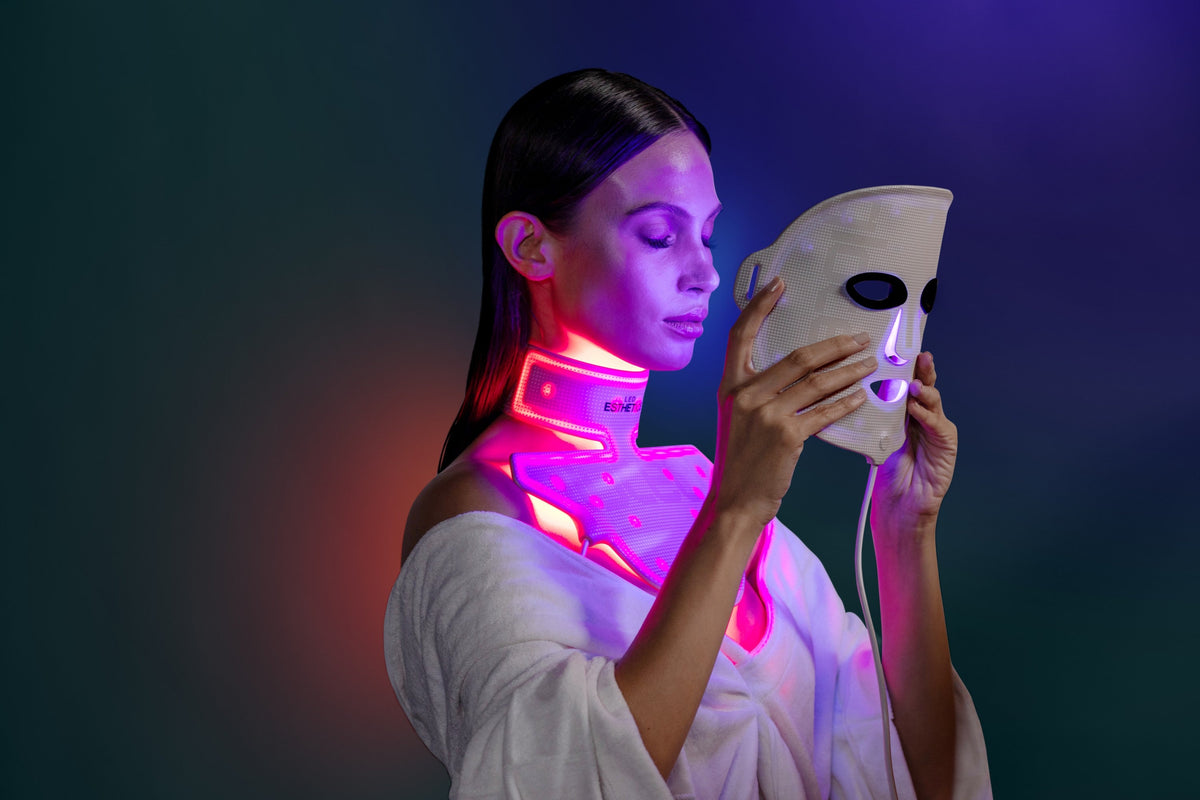
LED Light Therapy Colors That Work
|
|
Time to read 4 min
|
|
Time to read 4 min
THE-GLO-GUIDE [05-05-2025]
by LED SCIENCE
LED light therapy has become a staple in skincare routines across the globe, promising visible results through the power of targeted wavelengths. But as more at-home devices and spa treatments flood the market, so too does confusion, especially around LED colors. Many masks now claim to offer the benefits of seven, even eight different light colors. But is more always better?
In this guide, we break down what each LED color actually does, which ones are backed by science, and why blue, yellow, red, and infrared remain the gold standard for results. We’ll also introduce the LED Esthetics GloTech™ Mask Pro, one of the most advanced at-home LED face masks available today.
Table of contents
LED light therapy uses colored light emitted by nonthermal, noninvasive diodes. This means there’s no heat, no skin damage, and no need to break the skin barrier for results. Unlike sunlight, LED devices do not emit ultraviolet radiation, making them safe for regular skincare use. It’s a gentle yet powerful way to activate the skin’s natural healing processes.
Each LED color corresponds to a specific light wavelength, measured in nanometers. These wavelengths determine how deeply the light penetrates into the skin, and what effects it has:
Shorter wavelengths like purple, blue, and green light (around 400–470nm) remain closer to the surface of the skin, targeting bacteria, inflammation, and oil production.
Longer wavelengths like yellow, orange, red, and infrared light (up to 850nm) penetrate deeper into the dermis, stimulating collagen production, improving circulation, and reducing visible signs of aging.
By understanding the science behind LED wavelengths, it becomes clear why different colors are used for different skin goals, and why some lights deliver results while others are more hype than science.
You’ve probably seen them on social media: LED face masks that claim to offer seven different light colors, each with a distinct skincare superpower. Purple for healing, green for pigmentation, orange for glow, and the list goes on. But here’s the reality:
Most 7-color masks cycle through visible light without offering the specific wavelengths or output required for true therapeutic results. These lights may look impressive but often lack the clinical power or targeted efficacy of medical-grade devices.
There’s no harm in them, but if you’re looking for real change in your skin, it’s smarter to focus on colors proven to work.
If you’re serious about achieving visible results, focus on clinically proven wavelengths that deliver real change. Here are the LED light colors most recommended by dermatologists and skin professionals to include in your skincare routine, each backed by science and results-driven benefits.
Red Light
Red light (630–660nm) is one of the most powerful wavelengths used in skincare. It penetrates deep into the skin’s dermis to activate fibroblasts, the cells responsible for producing collagen and elastin. These structural proteins are essential for firm, plump, and youthful-looking skin.
Benefits of Red Light Therapy:
Smooths fine lines and reduces wrinkles
Increases skin elasticity and firmness
Stimulates collagen production for long-term rejuvenation
Enhances circulation, bringing oxygen and nutrients to the skin
Reduces redness and calms inflammation
Blue Light
Blue light (around 415nm) is one of the most widely used and clinically supported colors in dermatology. It penetrates the upper layers of the skin and targets Propionibacterium acnes , the bacteria that causes breakouts and oily skin.
Benefits of Blue Light Therapy:
Eliminates acne-causing bacteria
Reduces oil production
Calms inflammation and redness
Helps prevent future breakouts
Yellow Light
Yellow light (around 590nm) works just below the surface to boost circulation, support lymphatic drainage, and reduce redness. If your skin tends to react easily or you’re recovering from procedures like microneedling or peels, yellow light is an excellent addition.
Benefits of Yellow Light Therapy:
Soothes redness and irritated skin
Speeds up post-treatment recovery
Improves skin tone and fades dark spots
Supports oxygen and nutrient flow to skin cells
Infrared Light
Infrared light (810–850nm) goes even deeper than red light, reaching into the subdermal layers of the skin. Though invisible to the naked eye, it plays a crucial role in cellular repair, healing, and regeneration.
Benefits of Infrared Light Therapy:
Supports deeper tissue healing and cellular energy production
Boosts collagen synthesis and enhances skin density
Reduces chronic inflammation
Aids in joint and muscle recovery when used on the body
Helps with wound healing and post-treatment recovery
The GloTech™ Mask Pro by LED Esthetics focuses on what actually works. Instead of trying to impress with color variety, this device delivers clinical-strength wavelengths in red, blue, and infrared, chosen specifically for their research-backed benefits.
With a flexible silicone design, medical-grade LEDs, and optimized skin contact, the GloTech™ Mask Pro offers a full LED face treatment that’s powerful, non-invasive, and easy to use.
Key features include:
FDA-cleared wavelengths for safe, effective use
Pre-programmed modes for different skin goals
Soft, ergonomic fit for better light absorption
Convenient treatments in just minutes per session
With so many devices claiming to offer multicolor benefits, it’s easy to get distracted by marketing hype. But when it comes to LED light therapy, results aren’t about how many colors you use, they’re about using the right wavelengths consistently. Red, blue, yellow, and infrared light have stood the test of clinical research for a reason: they work.
That’s why a device like the GloTech™ Mask Pro was built around these core colors, delivering targeted results for concerns like acne, aging, redness, and skin dullness. No gimmicks. No unnecessary light settings. Just proven, powerful light therapy in a comfortable, wearable design—made for consistent, effective use at home.
Invest in what works. Discover the GloTech difference and treat your skin to smarter, science-backed LED technology.

